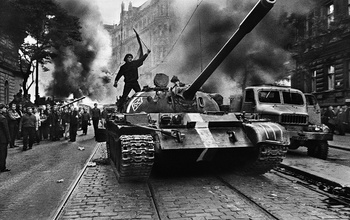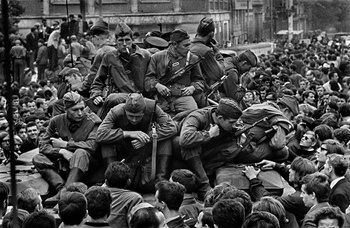Not every great struggle has been immortalised by a photographer of Josef Koudelka’s calibre. The response of the Czechs and Slovaks to the invasion of their capital by Soviet tanks in 1968, however, was. As part of the Summer of Photography, the Botanique is exhibiting the eminent photographer’s legendary images.
© Josef-Koudelka-Magnum-Photos
Wednesday 21 August 1968. Brezhnev dumbfounds the Czechs and Slovaks. The General Secretary of the Communist Party has decided to send his tanks to Prague to remind those who dared to forget that, in the Soviet bloc, he’s the boss. The streets are seething, contorting, embattled. A man weaves through the frantic crowd, the tanks with their phallic guns, the frenzied youth in their human chains, watching and snapping. This young man in his thirties, with round spectacles and an Exakta camera, is Josef Koudelka. He is about to join Magnum and become one of the most influential photographers of his generation, on a level with Robert Frank and Henri Cartier-Bresson, but he doesn’t know it yet.
Koudelka was not the only reporter present to immortalise the brutal Soviet response to the push for freedom by the peoples of Czechoslovakia, known as the Prague Spring, led by young people and intellectuals. It was his images, however, that would be seen around the world and help to turn the Prague resistance into a symbol. Perhaps, through these bodies and faces in conflict, it’s the entire history of the twentieth century that is on show.

© -Josef-Koudelka-Magnum-Photos
In that symbolic year, 1968, Koudelka was at a crucial turning point in his life. He had recently chucked in his studies in aeronautical engineering to embrace a nomadic life as an adventurer, sleeping under the stars, travelling Europe with a small rucksack to photograph Gypsy communities. His series “Gypsies” is now considered a seminal work of contemporary photography. Through the lens of his camera, Koudelka seeks to capture and reveal the thirst for freedom on the faces of his Prague brothers.
That could be why so many of the photos show people looking directly into the camera. Amid the smoke, broken windows, and bullet-riddled walls, the eyes of the demonstrators of all ages and of the bewildered soldiers (themselves not understanding what they are doing there) appear to be questioning the photographer as he tries to find his own reflection in them. It is, after all, the emotions that give such power to this high-contrast black and white photo-reportage, which Magnum hastened to publish anonymously under the initials PP for “Prague Photographer” (to protect the photographer and those close to him). The anger and incomprehension, the exhilaration and rage of the struggle, the violence of confrontation, the bitter-sweet agony of hope, the fear of tomorrow, the joy of feeling that you exist. In Koudelka’s work, it is above all humanity that expresses itself. Fifty years later, this shows through even more clearly.

© -Josef-Koudelka-Magnum-Photos
Read more about: Expo , Botanique , summer of photography




Fijn dat je wil reageren. Wie reageert, gaat akkoord met onze huisregels. Hoe reageren via Disqus? Een woordje uitleg.